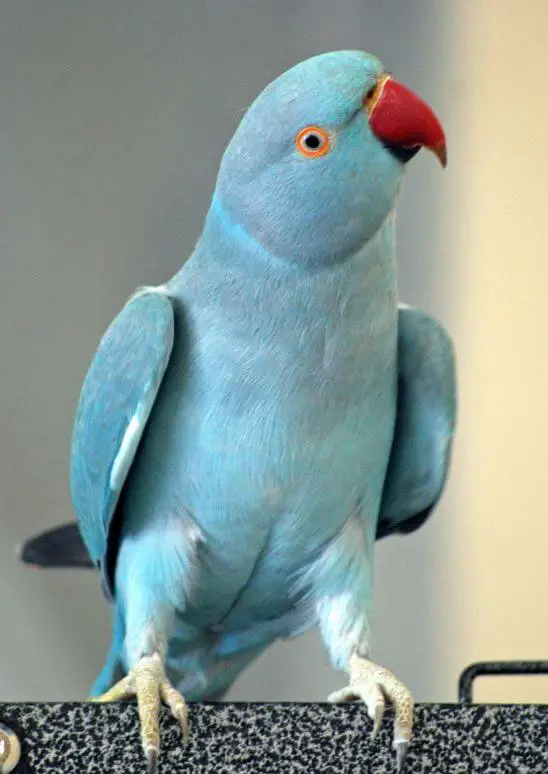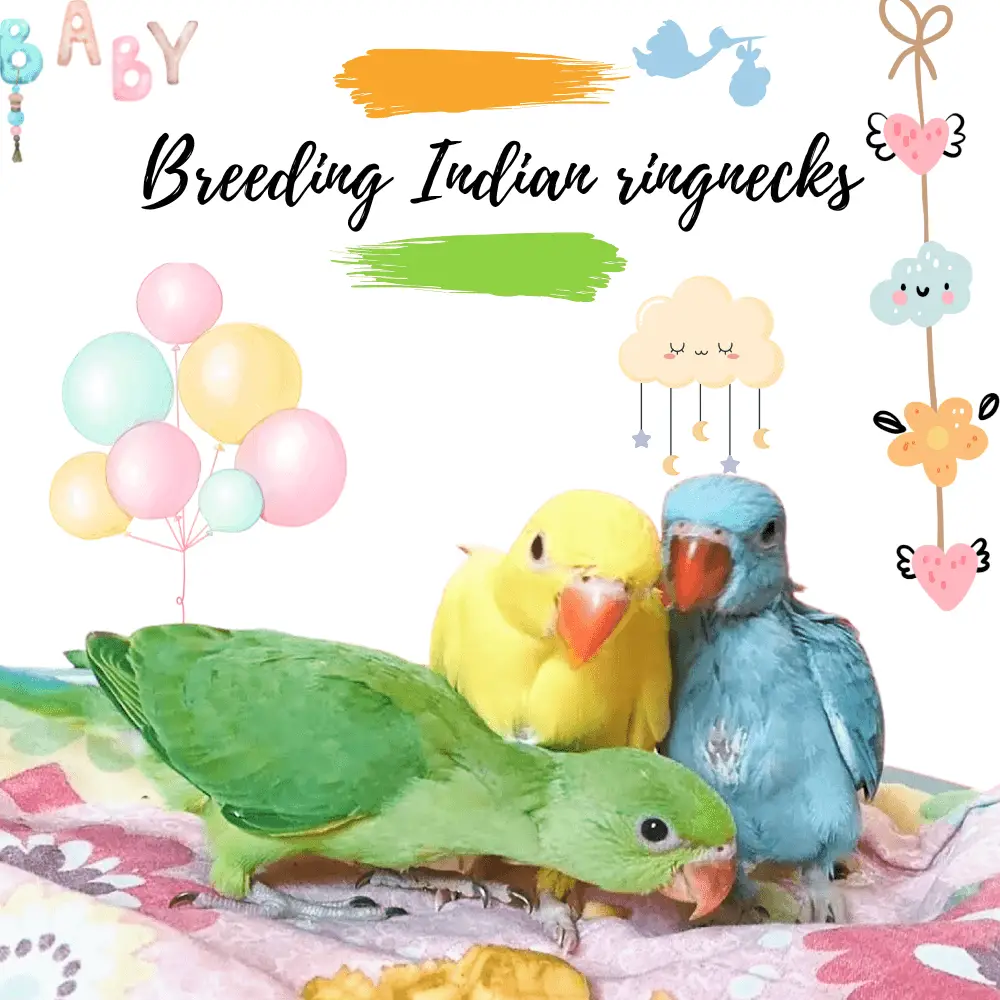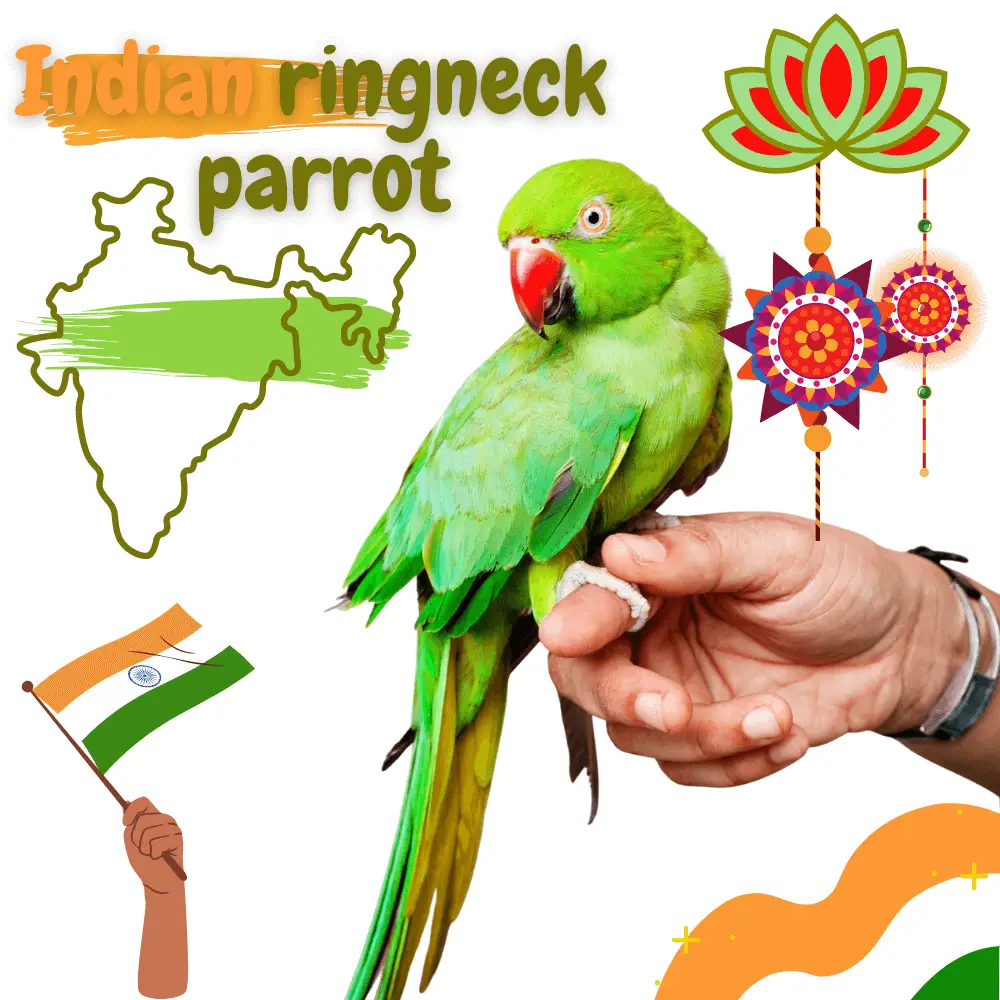Indian ringneck parrot: Characteristic green plumage, red and black beak, long bluish tail… it is not very difficult to recognize a ring-necked parakeet, a magnificent parrot belonging to the Psittacidae family. Robust, affectionate, and easy to maintain, the ring-necked parakeet is highly appreciated by breeders, but also by individuals. Let’s discover together the main characteristics of this psittacine and how to take care of it on a daily basis.
Ringneck parrot facts
The ring-necked parakeet takes its name from its appearance, more specifically from its collar, which is found exclusively in males. From its scientific name Psittacula Krameri, this parrot belongs to the large family of tropical parrots( Psittacidae ), in the same way as parrots, parakeets, or lorises.
The Indian ringneck parrot is of mixed, Afro-Asian descent, regions in which it mainly inhabits tropical crop areas and wooded savannahs. Despite its geographical origin quite far from our lands, the parrot is today very common in Europe.
Upon its introduction to the Old Continent, some of the ring-necked parakeets returned to the wild, either by escaping or because of abandonment. It is not uncommon to encounter Indian ringneck parrots in the wild, particularly in Italy, France, Belgium, and Great Britain.
From the point of view of its physical peculiarities, the ring-necked parakeet is easily recognizable by its beautiful green plumage, its long tail with azure blue reflections and the yellow tones under its wings. The lower mandible or maxilla of the parakeet is black in color while the maxilla is red in color. Generally, the plumage color of the male is more pronounced than in the female and juvenile parrots. Also, we told you, the characteristic black collar of this species is exclusive to males.
The latter is also the only one to have a red band on its tail. In adulthood, the ring-necked parakeet can measure up to 45 cm, have a wingspan of 47 cm and weigh almost 115 g. Finally, know that the Indian ringneck lifespan is 30 years old, so think twice before adopting it!
Indian ringneck personality

In terms of the character of the Indian ringneck parrot, a distinction must be made between parakeets in the wild and those living in captivity. In the wild, ring-necked parakeets are so-called gregarious parrots, which means that they live and congregate in large groups, either to forage or to breed. At night, the parrots sleep in groups on the trees, like a dormitory, and leave them in the morning to feed. From March to October, the ring-necked parakeets leave the trees to settle in other sites to reproduce.
In captivity, the Indian ringneck parrot is particularly easy to breed. She has an affectionate and happy character, which makes her an excellent companion. And because she is reputed to be robust, you won’t really have to worry about her state of health, as long as her cage and her food are suitable (we’ll come back to this a little later). And like other parakeets, the ring-necked parakeet enjoys games and interactions for their stimulating properties.
Indian ringneck food
Seeds, fruits, vegetables, rice, sprouts of legumes, flowers, berries, cereals, greenery… the ring-necked parakeet feeds exclusively on plant foods. In the wild, this parakeet poses a real problem for farmers, particularly in Asia, where it attacks cereal and fruit crops. Strangely enough, this is not the case in Europe.
Breeding Indian ringnecks

The sexual maturity of the ring-necked parakeet begins at the age of 3 years, or at 2 years more rarely. In the wild, the breeding period of the ring-necked parakeet extends from March / April to the end of autumn.
During this nuptial period, it is customary for male and female parrots to make mutual offerings. It is also during this period that the parrot builds its nest, which it prefers to install in hollow trees. You should know that the parrot has only one brood per year, and after mating, the female lays 2 to 6 eggs which she incubates for 21 days.
The chicks come out of their shells with pink skin and no down. They stay in the nest where they are fed by both parents at the beak until the age of 40 days. From then on, they timidly begin to take flight, but they continue to need their parents for food. A month later, the juveniles become able to feed themselves, like adults! It happens, however, that they continue to live as a family with their parents until the next brood.
Indian ringneck parrot health
We told you, the ring-necked parakeet is particularly robust and resistant. But that doesn’t mean she isn’t susceptible to certain illnesses, including Pacheco’s disease, or even chlamydia.
Indian ringneck parrot for adoption

The ring-necked parakeet is certainly very easy to raise, but that does not exempt you from respecting certain basic rules and good breeding practices, the goal being to put the parrots in the best possible conditions to flourish and prosper. In captivity, the ring-necked parakeet doesn’t have many needs, but it does.
On the one hand, the parrot appreciates space. This is why it is preferable to dedicate a large sailboat to it rather than a cage. It can also be placed outside, on the terrace, or in the garden, as long as you have a shelter to protect the parrots from the weather.
As for the dimensions of the ring-necked parakeets canopy, ideally, allow 4 meters in height for a pair of parakeets. The sailboat must also be equipped with a water tank for the parrots to bathe in spring and summer, two perches, and a 50 cm high nest box where the ring-necked parakeets like to take shelter.
How to feed an Indian ringneck parrot? We told you, the parrots feed exclusively on plants, so you will have no difficulty finding it. You can get ring-necked parakeet food at pet parrot stores, but the bulk of their food may come from your vegetable garden.
Ideally, provide your parrots with fruits, vegetables, corn on the cob, unsprouted seeds, and why not a vitamin and mineral complex to supplement their diet. And don’t forget fresh, clean water! On another note, do not hesitate to deworm your ring-necked parakeets at least once a year.
Finally, be aware that the ring-necked parakeet is rather shy, like all parrots. It takes time for him to get used to his master. So you have to be patient. You must also be particularly attentive to your ring-necked parakeet, as this one needs attention.
Ultimately, you will be able to enjoy the company of a pleasant and affectionate parakeet, which appreciates handling, provided that you have accustomed it to being handled. Do you want to adopt a ring-necked parakeet? Take a look at our ads section

